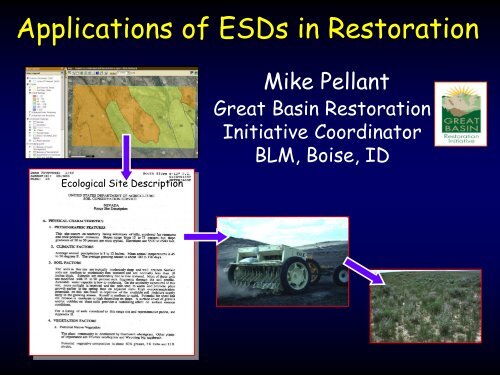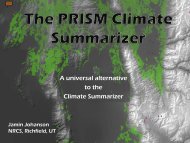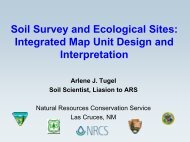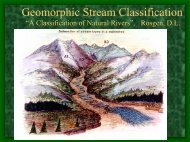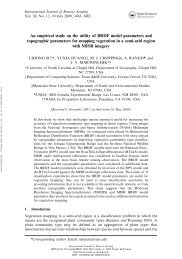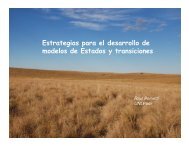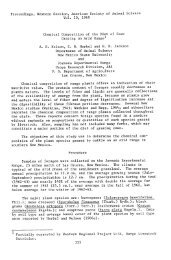Applications of ESDs in Restoration
Applications of ESDs in Restoration
Applications of ESDs in Restoration
You also want an ePaper? Increase the reach of your titles
YUMPU automatically turns print PDFs into web optimized ePapers that Google loves.
<strong>Applications</strong> <strong>of</strong> <strong>ESDs</strong> <strong>in</strong> <strong>Restoration</strong><br />
Ecological Site Description<br />
Mike Pellant<br />
Great Bas<strong>in</strong> <strong>Restoration</strong><br />
Initiative Coord<strong>in</strong>ator<br />
BLM, Boise, ID
<strong>Restoration</strong> Def<strong>in</strong>ition--Society for<br />
Ecological <strong>Restoration</strong> (2004)<br />
Ecological restoration is the process <strong>of</strong> assist<strong>in</strong>g<br />
the recovery <strong>of</strong> an ecosystem that has been<br />
degraded, damaged, or destroyed.
BLM National<br />
Tra<strong>in</strong><strong>in</strong>g Center<br />
“<strong>Restoration</strong> <strong>of</strong><br />
Sagebrush<br />
Ecosystems” Course<br />
Class <strong>of</strong>fered <strong>in</strong> October<br />
2012 <strong>in</strong> Boise ID<br />
<strong>ESDs</strong><br />
NEPA, Contract<strong>in</strong>g, etc.
Landscape Scale and <strong>ESDs</strong><br />
Goal—Reduce Fragmentation <strong>of</strong> Sagebrush Steppe<br />
Where Potential for Success is High
Greater Sage-grouse Populations
Land Resource Regions and Major<br />
Land Resource Areas<br />
MLRAs<br />
http://www.nrcs.usda.gov/survey/geography/mrla/
Fragmentation Issue:Western Juniper<br />
Encroachment
Fragmentation Issue:<br />
Cheatgrass/Medusahead Wildrye Invasion
Selection <strong>of</strong> High Potential Treatment<br />
Sites to Benefit Sage-Grouse
Soil depth<br />
Soil Survey + <strong>ESDs</strong> Critical for<br />
<strong>Restoration</strong> Plann<strong>in</strong>g<br />
<strong>ESDs</strong> focus on the plant community and provide the<br />
general soils <strong>in</strong>formation but not the specific edaphic<br />
<strong>in</strong>formation required to plan most restoration treatments<br />
Salts or carbonates<br />
Surface rock
Steve Campbell, Soil Scientist<br />
USDA – Natural Resources Conservation Service<br />
West National Technical Support Center<br />
Portland, Oregon<br />
websoilsurvey.nrcs.usda.gov
Navigate to a<br />
BLM Field Office<br />
<strong>in</strong> priority sagegrouse<br />
habitat to<br />
select a<br />
treatment area.
Soil Map Units—<strong>Restoration</strong> Potential?
Soil Map Units—<strong>Restoration</strong> Potential?
Depth to a Soil<br />
Restriction Layer<br />
Click on ―View Description‖ to<br />
get more <strong>in</strong>formation about this<br />
soil property.<br />
Click on ―View Rat<strong>in</strong>g‖ to<br />
generate a map and report.<br />
Choice list for<br />
Aggregation Method
Depth to Lithic Bedrock<br />
MU 322-14 <strong>in</strong>ches<br />
MU 366-25 <strong>in</strong>ches
The Soil Data Explorer tab provides multiple options<br />
for display<strong>in</strong>g soils and ecological site <strong>in</strong>formation.<br />
The ―Suitabilities and<br />
The ―Soil Properties The ―Ecological Site<br />
Limitations for Use‖<br />
and<br />
tab<br />
Qualities‖ tab is Assessment‖ tab is<br />
is used to create maps<br />
used to create maps used to view and pr<strong>in</strong>t<br />
and reports <strong>of</strong> a s<strong>in</strong>gle<br />
and reports for a s<strong>in</strong>gle sections <strong>of</strong> Ecological<br />
<strong>in</strong>terpretation such<br />
soil<br />
as<br />
property such as Site Descriptions.<br />
―Rangeland Seed<strong>in</strong>g,<br />
Percent Clay <strong>in</strong> the<br />
Great Bas<strong>in</strong> Ecoregion‖.<br />
surface horizon.
Ecological Site Information
The Land Management category conta<strong>in</strong>s numerous<br />
<strong>in</strong>terpretations related to restoration practices.
Description: Mechanical Treatment, Shredder
Potential for Mechanical Treatment with a Shredder
Map Unit<br />
Description<br />
report
The ―Ecological Site Assessment” tab can be<br />
used to generate maps <strong>of</strong> the dom<strong>in</strong>ant ecological<br />
sites and reports <strong>of</strong> ecological site descriptions.
The ―Ecological Site Assessment” tab <strong>in</strong>cludes a<br />
report <strong>of</strong> Ecological Sites <strong>in</strong> the Area <strong>of</strong> Interest<br />
15%?
Not the Full Ecological<br />
Site Description
Historic Juniper Woodlands-Where do they occur?
Historic<br />
NAIP 1:2,000 ft<br />
Use 1 m 2 NAIP Imagery to Plan<br />
Appropriate Site-Level Treatments<br />
Encroachment
Phase I<br />
Phase II<br />
Phase III
Phase I<br />
Phase II<br />
Phase III
Thresholds <strong>in</strong> P<strong>in</strong>yon P<strong>in</strong>e/Juniper Encroachment <strong>in</strong>to<br />
Sagebrush Steppe<br />
Underdown 1973<br />
Understory Leaf Biomass (kg/ha)<br />
1800<br />
1600<br />
1400<br />
1200<br />
1000<br />
800<br />
600<br />
400<br />
200<br />
0<br />
Underdown Canyon Demonstration Area<br />
Woodland Dynamics<br />
Tree Leaf Biomass<br />
Understory Leaf Biomass<br />
Phase I Phase II Phase III<br />
r 2 = 0.84<br />
r 2 = 0.94<br />
Threshold<br />
Species Composition<br />
Change & Production<br />
r 2 = 0.83<br />
Underdown 2005<br />
0.0 0.2 0.4 0.6 0.8 1.0<br />
Relative Tree Dom<strong>in</strong>ance (%Tree Cover / % Total cover)<br />
18000<br />
16000<br />
14000<br />
12000<br />
10000<br />
8000<br />
6000<br />
4000<br />
2000<br />
0<br />
Tree Leaf Biomass (Kg/ha)
Threshold Progression<br />
Changes <strong>in</strong><br />
Species<br />
Comp.<br />
& Invasives<br />
Species<br />
Loss<br />
Briske et al. 2006<br />
Disrupted<br />
Ecological<br />
Processes
Whisenant (1999) “Repair<strong>in</strong>g Damaged Wildlands”<br />
―Tweak‖ Mgt.<br />
Veg.<br />
Modi-<br />
fication<br />
Whisenant table<br />
Physical<br />
Environment<br />
Modification<br />
Ecological<br />
Processes
<strong>Restoration</strong>-Is reestablish<strong>in</strong>g previous plant<br />
composition & lost species adequate…?<br />
…or has the site potential decl<strong>in</strong>ed (soil<br />
loss) to the po<strong>in</strong>t that reseed<strong>in</strong>g may not<br />
be the first treatment?
Phase I<br />
<strong>Restoration</strong> Options
Cheatgrass<br />
Phase II<br />
<strong>Restoration</strong> Options<br />
Cha<strong>in</strong>saw & Mastication but Fire?<br />
Cha<strong>in</strong><strong>in</strong>g
Phase I <strong>Restoration</strong> Options<br />
Cha<strong>in</strong><strong>in</strong>g, Mastication<br />
Not Fire & Requires<br />
reseed<strong>in</strong>g<br />
Herbaceous/Sagebrush<br />
Cheatgrass What to seed?
Evaluate<br />
where you<br />
are <strong>in</strong><br />
relation to<br />
ESD and<br />
appropriate<br />
species to<br />
seed
The Land Management category conta<strong>in</strong>s numerous<br />
<strong>in</strong>terpretations related to restoration practices.
USGS Excel Seed Mix Calculator<br />
VegSpec is Gone
Incorporat<strong>in</strong>g <strong>ESDs</strong> (<strong>in</strong>clud<strong>in</strong>g Reference Sheets) and Soil<br />
Survey <strong>in</strong>to a Sagebrush <strong>Restoration</strong> Strategy<br />
Pyke, D. A. 2011. Restor<strong>in</strong>g and rehabilitat<strong>in</strong>g sagebrush<br />
habitats. Pp. 531–548 <strong>in</strong> S. T. Knick and J. W. Connelly<br />
(editors). Greater Sage-Grouse: ecology and conservation <strong>of</strong> a<br />
landscape species and its habitats. Studies <strong>in</strong> Avian Biology (vol.<br />
38), University <strong>of</strong> California Press, Berkeley, CA. (onl<strong>in</strong>e at<br />
www.sagemap.gov)<br />
Ecologically Based Invasive Plant Management Project<br />
www.ebipm.org
Pyke, D. A. 2011.
Pyke, D. A. 2011.<br />
<strong>ESDs</strong><br />
NEPA, Contract<strong>in</strong>g,<br />
etc.
Pyke, D. A. 2011
Reference<br />
Sheet-<br />
<strong>Applications</strong><br />
to<br />
<strong>Restoration</strong>
Incorporat<strong>in</strong>g Reference Sheets <strong>in</strong>to an Invasive<br />
Plant Strategy<br />
Addresses the spread <strong>of</strong><br />
cheatgrass and medusahead <strong>in</strong><br />
the Great Bas<strong>in</strong> through the<br />
implementation <strong>of</strong> ecologicallybased<br />
pr<strong>in</strong>ciples.<br />
(www.ebipm.org).
Assessment Worksheet
Summary<br />
• <strong>ESDs</strong> and soil surveys are <strong>in</strong>tegral <strong>in</strong> restoration<br />
plann<strong>in</strong>g.<br />
• Soil surveys (Web Soil Survey) provides the essential,<br />
detailed <strong>in</strong>formation on soil limitations and properties<br />
necessary for restoration plann<strong>in</strong>g and implementation.<br />
• <strong>ESDs</strong> provide the ecological background to understand<br />
community pathways and develop restoration strategies<br />
to meet management objectives.


